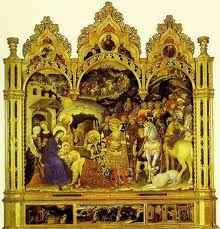Saturday, October 20, 2012
Albrecht Durer, Self Portrait, 1500
This painting is a self portrait of a German painter named Albrecht Durer. I think this painting is interesting because I always wonder how many of the famous renaissance artists looked; and I feel like Durer portrayed himself realistically. Durer was also the closest thing to a Da Vinci the Northern European renaissance had. In addition to being an artist, he was also a printmaker and mathematician. I've recently just discovered him in art class, and I think I was truly missing out before I became a witness to his work. He was truly a great genius and talent of his day.
Parmigianino, Madonna with the Long Neck, 1534-1540
Although I think Parmigianino did a pretty good job creating this painting in the Manneristic style that stood in contrast to other renaissance paintings, I actually think Madonna long neck doesn't appear unnatural at all. Now, baby Jesus on the other hand, appears a bit long when compared to other renaissance portraits of baby Jesus. If anything, it is the image of baby Jesus that makes this painting sincerely Manneristic. Nevertheless, this is a true work art.
Titian, Pastoral Symphony, 1508-1511
Titan Vecelli, Pastoral Symphony, is a great presentation of a renaissanceVenetian painting. The Venetian style differed from other paintings in renaissance Italy because of the use of vivd color in Venetian style paintings. This painting makes me feel like I am in 16th century Italy.
Michelangelo, David, 1501-1504
How could I possibly talk about great Renaissance artists without mentioning Michelangelo. His David is second to no other. I like this David because in contrast to Donatello's David, this is the most realistic. This David looks like a real person.
Raphael, School of Athens, 1509 - 15011
Raffaello Sanzio da Urbino, or Raphael, painted this work of art for Pope Julius II in Rome. I like this portrait because Raphael included some of the worlds great philosophers, and a self portrait of himself. I also like Raphael's use of linear perspective. The structures within the painting appears to recede deep into space.
Michelozzo di Bartolomeo, Interior Court of the Palazzo Medici Riccardi, 1445
Michelozzo di Bartolomeo did an outstanding job with this design for the powerful Medici family. This interior courtyard of the Medici palace takes me back to ancient Rome, and not 15th century Italy. Perhaps, that was the intentions of Bartolomeo; maybe he wanted the Medici family to feel like they were in classical Rome instead of 15th century Italy.
Filippo Brunelleschi, Interior of the Pazzi Chapel, 1433
This Interior design was done by an Italian architect named Filippo Brunelleschi. I like this design because from the outside of the building it does not appear that such a design exist inside. For example, the view from outside of the Pazzi Chapel presents a much smaller structure; but the view from the inside makes the building appear much more spacious. The spacious presentation is, of course, a direct result of Brunelleschi usage of the dome.
Gentile da Fabriano, Adoration of the Magi, 1423
This painting is by Gentile da Fabriano, an Italian renaissance painter who specialized in the International Gothic style. I like this painting because it encompass the elegance, structure, and presentation that is characteristic of an International style type painting. The golden color give this painting a "heavenly" feel, and the audience is immediately lured into the sacred presentation.
Wednesday, October 10, 2012
Leonardo Da Vinci, Madonna on the Rocks, 1438
I personally think this is one of Da Vinci's most fascinating paintings. I think this painting is more beautiful than the Mona Lisa. Da Vinci was a master at depicting his art as mysterious and "smokey". This painting captures Da Vinci artistic contribution at its best.
Subscribe to:
Comments (Atom)








.jpg)